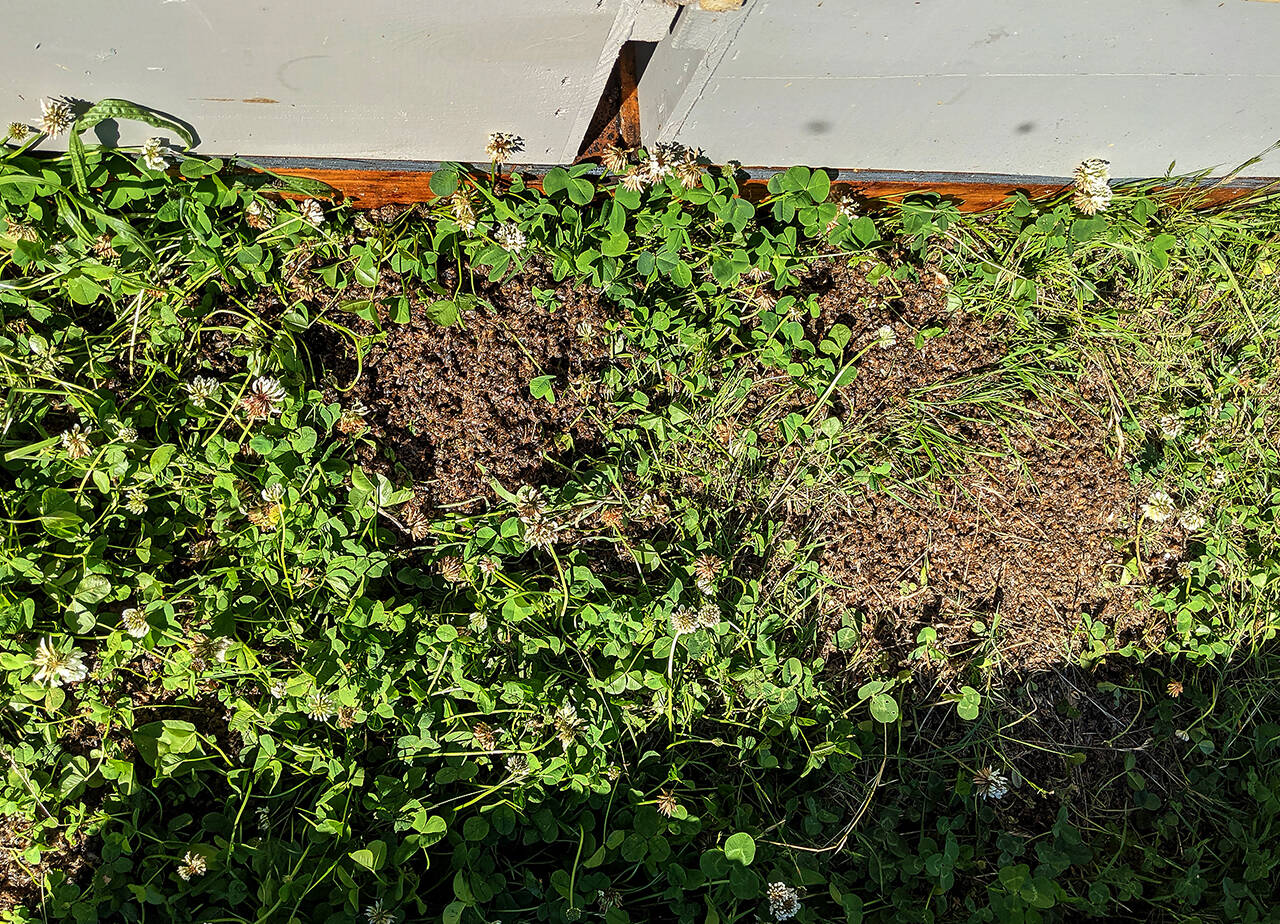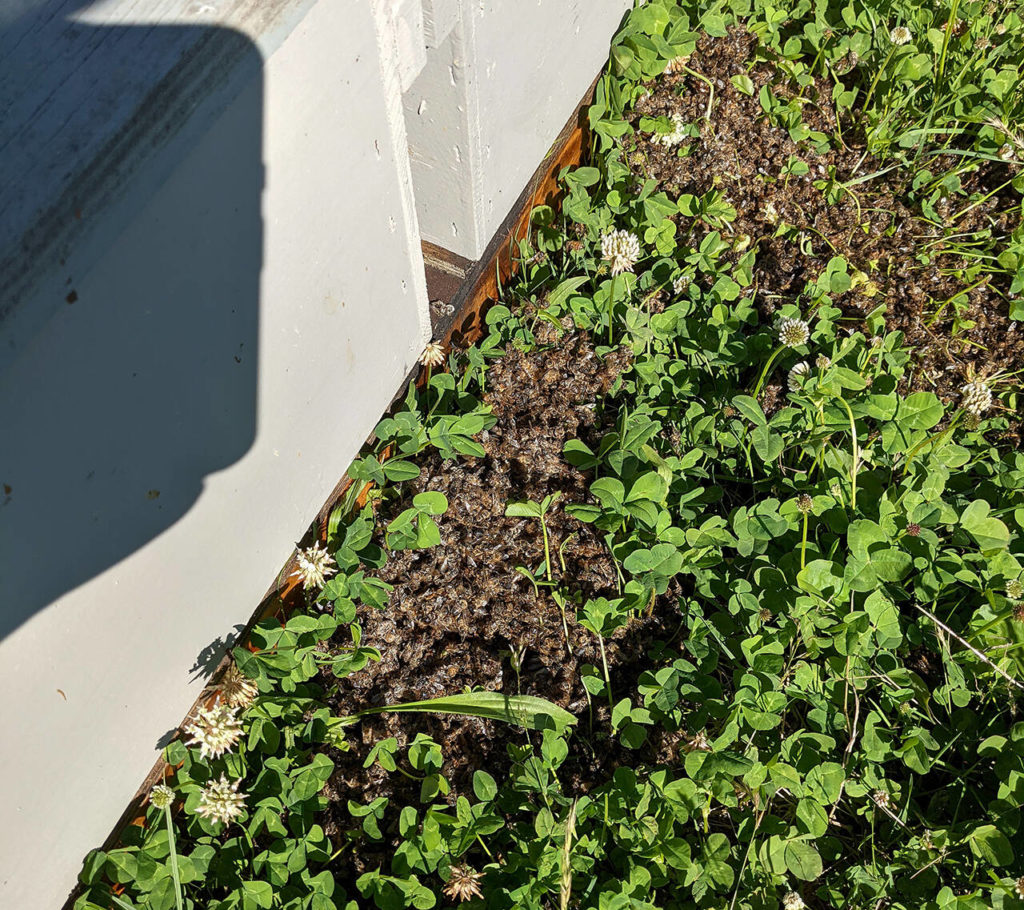EVERETT — The honey bee cadavers may have numbered in the millions.
Mounds of black-and-yellow stripes littered the ground last summer at Getchell Ranch, a small organic farm on Ebey Island, along the Snohomish River. All those legs and wings and mandibles and stingers, usually buzzing with activity, lay motionless.
State investigators and entomologists suspect pesticides that can be bought over the counter were the cause of death. Likely, they surmised, the bees foraged nectar and pollen from flowering plants ladened with the toxic chemicals, or drank from a contaminated water source. But they couldn’t figure out where the pesticides came from.
Nor could they confirm the exact death toll. By the time investigators got to the farm, the beekeeper had cleaned out some of the hives and moved many others to a nearby property, fearing more would get poisoned.
Bee kills like this have become rare in Washington in recent years, but the event in June serves as a cautionary tale: Misusing pesticides can bring harm to honey bees, a vital part of the state’s agriculture, and a livelihood to those who keep them. Experts urge people to avoid applying pesticides on plants while they’re in bloom, or near water sources that could attract thirsty bees, particularly on hot days. And they suggest using less toxic products.
The beekeeper in this case stands to lose a considerable amount of money, from replacing contaminated equipment to losing income in the pollination season. He takes his hives to California to pollinate almond trees, and to the Midwest for canola crops.
He arrived at Getchell Ranch on June 16 to find his bees dead and dying, according to a report by state investigators. He reported he lost 240 hives — each with tens of thousands of bees — out of about 1,400. In the decades he has been tending to hives at the farm, he had rarely seen so many die at the same time.
The bees had been alive just a couple of days before, the keeper reported, according to documents. A Herald reporter could not reach him for an interview.
The farm’s owner, Maria Foster, got in touch with Charlie Coslor, an entomologist with the Washington State University extension in Skagit County.
Coslor, also the director of Skagit County’s pest control board, has been working with bugs for over a decade. He said he hasn’t seen a scene quite like it before. He went to the farm, collected samples, froze them and sent them along to the state for testing.
The state Department of Agriculture’s pesticide compliance program reviewed the incident. Investigators started with a lineup of suspects: It could have been a nearby farm, or perhaps the county or the state played a role. Maybe the city of Everett was doing something at Rotary Park, just across the river. Or a water source might have been contaminated.
One by one, the suspects offered their alibis.
The state Department of Fish and Wildlife and the Snohomish County agriculture coordinator reported they didn’t spray in the area.
A maintenance supervisor with Everett Public Works said they used to treat some nearby detention ponds, but hadn’t done so since 2019. They also haven’t used any pesticides at Rotary Park, he reported.
Investigators tested nearby water sources, but didn’t find any noticeable amounts of contaminants.
Foster said she doesn’t think anybody on her side of the river had anything to do with it. She called her neighbors and knocked on their doors to make sure. She didn’t know anyone who would use pesticides on blooming plants.
She doesn’t use any herself, she said. Her farm is completely organic.
“I think chemicals are bad for the world,” Foster said. “I don’t like eating them and I don’t like them in my water and I don’t like to breathe them, so I’m not going to use them.”
She isn’t trying to bring anyone to justice, she said. She just wants to raise awareness around pesticides.
“I don’t think people realize, on one hand they say, ‘Save the bees, figure out why they’re disappearing,’” she said, “and then on the other hand they say, ‘Oh, we got bugs, let’s spray them.’”
Foster inherited the 94-acre farm a couple of years ago from her adopted father, Alex Alexander. Founded in 1873, Getchell Ranch is one of the oldest homesteads in the region. Foster is currently using it for sheep and goats and a small orchard, she said. And ranchers will rent out some pasture to let their livestock graze.
This summer, Foster worked with the Washington Farmland Trust to secure a conservation easement, a legal agreement that permanently limits uses on the property, effectively preserving it as a farm into the future.
Because bees can forage up to a couple miles away, pinpointing the source of the pesticides proved to be an impossible task, said Tim Schultz, compliance manager for the state’s pesticide management division. Around Getchell Ranch, there are other properties used for pasture, hay and grain. And across the river, there is a plethora of homes and businesses along the I-5 corridor.
If a source could be found, the state would have a couple of options, Schultz said. It could give a notice of correction, where the violator has a chance to correct course, or it could issue a fine. There would also be a chance for the beekeeper to get restitution for his losses.
“In this case, unfortunately, we weren’t able to find the source just because of the nature of the location, so we had to close it out,” Schultz said.
The whodunit may never have a suspect.
It has Coslor scratching his head.
“We know the murder weapon, I suppose,” Coslor said, “but not who did what, in what room, on the Clue board.”
After the state completed its testing, Coslor reviewed the chemical analysis of the bees and discovered high concentrations of pesticides.
“I saw the numbers and was like, ‘Wow, carbaryl was off the charts,’” he said.
At least one bee had over 15 times the lethal dosage.
Anyone can buy carbaryl at the store. It’s less toxic than pesticides that have been used in the past, but it can still be potent, especially to bees.
According to the U.S. Environmental Protection Agency, people who have prolonged exposure to carbaryl can suffer headaches, memory loss, muscle weakness and cramps. It was banned from store shelves in California last year because misuse would sometimes make people sick. A news release from the California Department of Pesticide Regulation notes most misuse happened in residential application, where people aren’t trained in the use of pesticides. Commercial users, meanwhile, must be licensed, the same as in Washington.
Historically, the pesticide has been sold under the brand name Sevin, though the company GardenTech has been moving away from using carbaryl in recent years. Sevin products have a warning that it could kill honey bees in substantial numbers if sprayed on blooming plants.
Labels on pesticide products carry the weight of federal law. Stray from the instructions and you could be penalized.
“In this case it just seems like the label wasn’t followed at all,” Coslor said.
Doing some back-of-the-napkin math, Coslor estimated it would take 24 grams of carbaryl to cause a bee kill of the scale seen at Getchell Ranch. That’s about the equivalent of what’s found in a one-pound container of Sevin “Ready-to-Use 5% Dust.” (Though if bees picked up the pesticide while foraging, it’s unlikely a single container was responsible for all those deaths.)
Thanks to restrictions and education, bee kills now happen in Washington just once or twice a year, said Katie Buckley, the state’s pollinator health coordinator.
“But unfortunately, either mistakes happen or malpractice happens,” she said.
Overall, farmers in the state have worked well with bees, Buckley said. Many keep pollinators in mind when using pesticides.
“Growers out here need the bees too,” she said. “They don’t want to kill the bees … they’re very tightly interwoven together.”
Buckley said June’s bee kill is a reminder that more work can be done. She leads a new state task force assigned to protecting pollinators, with a focus on education. In the near future, she said, the task force will start reaching out to people who might buy pesticides at local nurseries, as well as professionals who use pesticides commercially.
But pesticides are just one of many challenges confronting bees, Buckley said. They also have to deal with habitat loss, diseases and invasive species, like the now-infamous “murder hornets.”
Despite those obstacles, not everything is bad news for pollinators, Buckley said. She said more people are stepping up to help them. They’re thinking about how to grow pollinator-friendly gardens, how best to use pesticides or avoid them altogether, and how to pass laws with the critters in mind.
“I think there’s a lot of cause to be hopeful,” she said.
Zachariah Bryan:
Talk to us
> Give us your news tips.
> Send us a letter to the editor.
> More Herald contact information.


























